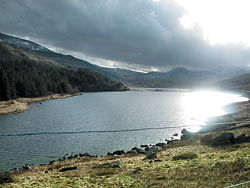Land of the kings

Located in Gwynedd County, it is named after the old Kingdom of Gwynedd. Though Gwynedd is geographically one of the biggest counties, it is one of the most sparsely populated areas in North Wales. Most of the people speak Welsh. The majestic Snowdon mountain is located in the heart of Snowdonia National Park in Gwynedd, North Wales with some of the most ancient rocks in the world, at an altitude of 3,560 ft above sea level.
It is the highest peak in Wales and Great Britain’s highest mountain, south of the Scottish Highlands. In Welsh language, it is called Yr Wyddfa, and is steeped in history and benefits from some of the most beautiful views in all of Britain. Snowdon is a national symbol for the Welsh people. It is glacially eroded with quarries surrounding it, which makes it popular amongst amateur and professional walkers. Some of the famous visitors to Snowdon include Edmund Hillary, who underwent training here before he conquered Mount Everest in 1953, William Gladstone, and poet William Wordsworth.
Often cloud-capped between October and June, Snowdon is soaked in legend, and is reputed to be the burial place of the giant ogre Rhita, vanquished by the famous King Arthur. The names of places in Welsh are often little difficult to pronounce for an outsider.
They are often combinations of descriptive and poetic terms in Welsh. Some of the common terms you will come across are Aber (mouth of a river), Afon (river), Bryn (hill), Cymru (Wales), Dyffryn (valley), Llan (church), Llys (court, palace), Mawr (large), Pont (bridge), etc.
The English name Snowdon comes from the Saxon Snow Dun, which means snow hill. Snowdon has one of the wettest climates in Great Britain, and has everything, right from the rarest flowers, insects, ruined mines, fascinating volcanic rock formations to fossils.
The top of the mountain is often covered by fog and mist and the weather is very unpredictable. As we started our journey, the weather was gloomy, but as we entered the Welsh mountains, a warm smile lit up our faces as the mountain was bathed in sunlight, gradually.
Snowdon also provides train facility up the mountain. Started in 1896, Snowdon Mountain Railway is a great way to reach the summit. The train starts from Llanberis station and provides breathtaking views as it chugs its way up the mountain. It returns from the
summit after 2 1/2 hours, which includes a 30-minute stop at the peak.
On our return journey, we visited a historical town called Caernarvon, located at the northern edge of Snowdonia, which separates Anglesey from North Wales. It is one of the many Edwardian Castles and is an impressive structure with its unique polygonal towers. This is one of the finest examples of medieval castle architecture in Wales.
Caernarvon lies on the west end of the Menai Strait, standing in a magnificent position at the foot of the mountains, overlooking Anglesey. The majestic Caernarvon Castle stands on the busy quayside, at the mouth of River Seiont (Afon Seiont in Welsh), which runs into the Irish Sea. The castle was built by King Edward I in 1283, following his conquest of Wales, and is now a UNESCO World Heritage Site. “In this very castle, Prince Charles’s investiture took place in 1969 as the Prince of Wales,” said our host, while I was mesmerised by the beauty of River Seiont, which was filled with many tourist boats, right in front of the castle.
As we were getting ready to leave the castle, our host added, “If we take a small deviation from here, we can easily reach Bangor, another tourist attraction.” Just 15 miles away from the summit, and nine miles from Caernarvon, Bangor is one of the smallest cities in UK and is known as the cathedral and university city of North Wales.
Another must-visit place is the Bala Lake on the edge of Snowdonia. About 4.5 miles long and about a mile wide, it is the largest natural lake in Wales. This water body is known as the lake of serenity. The small town of Bala at the northern end of the lake is an excellent fishing and sailing centre. The slate quarries is another tourist attraction. This town is called Blaenau Ffestiniog. Over centuries, slate quarries have been an integral part of Snowdonia’s culture and heritage. They have contributed towards shaping and influencing the town’s landscape. Some of the villages and towns surrounding them were developed to provide homes for the quarrymen and their families.
Betws-y-Coed is a popular Welsh tourist village that stands at the junction of three of Snowdonia’s rivers and their valleys, surrounded by the Gwydyr Forest. Betws-y-Coed means ‘prayer house in the wood’. This victorian town is the principal village of the Snowdonia National Park and is also a popular inland resort. The picturesque Pont-y-Pair Bridge, built in 1468, and the spectacular Swallow Falls, the highest continuous waterfall in Wales, are a treat for the eyes.
Portmeirion, another stunningly beautiful village, situated on the estuary of River Dwyryd is worth a visit. Television series and films have shot extensively at Portmeirion, often depicting the village as an exotic European location. Our host wanted to take us to Welsh Mountain Zoo, to have a glimpse of snow leopards, brown bears, Sumatran tigers, red pandas, camels, penguins, alligators, wild horses and much more, but unfortunately, due to lack of time, we could not make it.
Thanks to our trip, we also visited the town with the longest name in the world – Llanfairpwllgwyngyllgogerychwyrndrobwllllantysiliogogogoch. This Welsh town is situated on the Isle of Anglesey and its name means — the church of St Mary in the hollow of white hazel trees near the rapid whirlpool by St Tysilio’s of the red cave.
Deccan Herald is on WhatsApp Channels| Join now for Breaking News & Editor's Picks